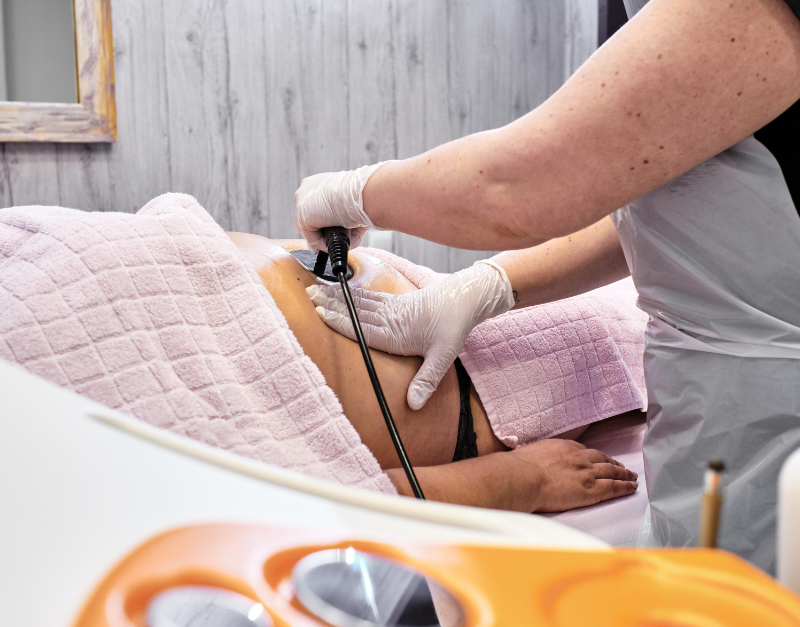
Quality Treatment With Super Affordable Price
Best Physiotherapy Treatment India
Call us anytime
Write a mail

Unlocking the Heat: Understanding Shortwave Diathermy (SWD) in Physiotherapy Harnessing High-Frequency Alternating Currents for Healing Shortwave diathermy (SWD) is a treatment method that generates heat within the body’s tissues using high-frequency alternating currents. When used correctly, this heat can provide a variety of physiological advantages, making SWD a powerful tool in physiotherapy. How Does Shortwave Diathermy (SWD) Work? Electromagnetic Waves and Tissue Healing Shortwave treatment uses high-frequency electromagnetic radiation that enters the patient’s body and is absorbed by the tissues. This contact causes ions to move, resulting in friction, which lowers joint discomfort and promotes soft tissue healing. Continuous Shortwave Diathermy (CSWD) and Pulsed Shortwave Diathermy (PSWD) are the two primary modalities of SWD, each with specific thermal and athermal effects. Parameters of SWD Treatment Fine-Tuning the Therapy Understanding and changing SWD parameters is critical to its success: Physiological Effects of SWD Beyond the Surface: Healing from Within SWD converts electromagnetic waves into heat as they pass through biological tissues using condenser plates or induction coils. The physiological impacts are significant: Benefits of Shortwave Diathermy (SWD) Maximizing the Therapeutic Arsenal SWD combines effortlessly with other physiotherapy methods, providing a comprehensive approach to rehabilitation. Key advantages include reduced pain and inflammation. Conditions Treated by SWD A Versatile Solution for Musculoskeletal Woes SWD is applied across a spectrum of musculoskeletal conditions, including: Contraindications of SWD Knowing When to Pause To ensure the safety of patients, physiotherapists must be aware of contraindications, including: Side Effects of SWD Balancing the Benefits with Caution While SWD is typically safe, it does pose certain dangers, including: Precautions for Safe SWD Application Ensuring a Secure Treatment Environment Physiotherapists must do the following to improve safety during SWD treatment: SWD is a formidable ally in the Gold Medal physiotherapist‘s armoury, providing a varied and successful approach to addressing musculoskeletal disorders. However, to provide a safe and productive therapeutic experience, its implementation necessitates a detailed grasp of limitations, precautions, and contraindications. SWD has enormous therapeutic potential when used with care and knowledge, offering comfort and healing to needy individuals. FAQs

Muscle stiffness is a common condition that affects people of all ages. It is characterized by tightness and difficulty moving, especially after periods of rest. While it normally goes away on its own, prolonged stiffness may be an indication of underlying concerns that need to be addressed. In this blog, we’ll look at the causes, risk factors, preventative measures, and treatment choices for muscular stiffness. The physiotherapy treatment for muscle stiffness is very affordable in Gurgaon at Gold Medal Physiptherapy, you should check it out. Causes of Muscle Stiffness: Unraveling the Knots Muscle stiffness can be caused by a variety of circumstances, including exercise, physical exertion, or even chronic inactivity. Sprains and strains are common culprits, producing pain that can be relieved with home treatments and stretching. Some disorders, however, need extra attention. This illness, which is more common in those over the age of 70, can cause stiffness, particularly in the upper torso, shoulders, neck, arms, and hips. Both disorders are associated with chronic weariness and muscular discomfort, both of which contribute to stiffness. A variety of external sources, such as bug bites, illnesses, or exposure to excessive heat or cold, can cause muscle stiffness. Serious bacterial infections, such as tetanus and meningitis, can cause muscular stiffness, along with other concerning symptoms such as trouble swallowing or a stiff neck. Identifying Risk Factors: Who’s Prone to Muscle Stiffness? Infants, young children, and anyone over the age of 65 are at a higher risk of experiencing muscular stiffness. Along with it, heavy alcohol intake, and illnesses such as hypothyroidism can all increase the likelihood of having muscular stiffness and cramps. Preventive Measures: Taking Strides Towards Flexibility Maintaining a healthy lifestyle can help avoid muscular stiffness. Here are some muscle stiffness preventative steps to think about: To reduce unneeded muscular strain, make sure your furniture at home and work promote healthy posture. To counteract stiffness, incorporate breaks within your regimen. To keep your muscles supple, stand up, stretch, and go for brief walks. Stay hydrated and eat a well-balanced diet high in calcium and magnesium for maximum muscular health. When to Seek Medical Help: Warning Signs to Look Out For While muscular stiffness is usually harmless, certain symptoms need medical attention. If the stiffness persists or is accompanied by fever, acute weakness, edema, or discomfort, seek immediate medical attention. These symptoms may signal an underlying illness that needs a comprehensive examination. Treatment Overview: Unraveling the Knots Seeking medical treatment while experiencing recurrent muscular stiffness is critical. To determine the core reason, your doctor will do a thorough examination, which may include blood tests, X-rays, or scans. The diagnosis determines treatment and may include anti-inflammatory drugs to relieve discomfort. Gold Medal Physiotherapy Home Treatments: Soothing Stiff Muscles Naturally Gold Medal Physiotherapy Home treatments might be beneficial in mild situations. Common practices include rest, massage, and the administration of heat or cold. Heat may be better for tight muscles, although cold might help reduce swelling and inflammation. Stretching on a regular basis, warm baths, and focused massages can all help with muscular flexibility and general comfort. Gold Medal Physiotherapy Treatments: A Guided Approach to Flexibility Physiotherapy is an effective treatment option for both muscle and joint discomfort. Gold Medal Physiotherapists can improve joint range of motion, muscle length, and discomfort and give self-management skills through exams, recommendations, and tailored treatments. Joint mobilization, range of motion exercises, and acupuncture can all be used to relieve stiffness successfully. To summarise, understanding muscular stiffness entails identifying its causes, identifying risk factors, and implementing preventive measures. While many instances may be treated by physiotherapy at home, persistent or severe symptoms necessitate expert care. Individuals should aim for flexibility and general well-being by taking a proactive approach to muscle health, including frequent exercise, eating a balanced diet, and getting timely medical care when necessary. FAQs Muscle stiffness can be caused by a variety of medical disorders. Mentioned here SPS is a rare neurological condition characterised by growing muscular stiffness and repeated painful spasms. Muscle stiffness can also develop when muscles are overused. Is muscular stiffness a cause for concern? Stiffness is visible when muscles are tight, difficult to move, and produce discomfort. This is frequently accompanied by cramping and pain, but simple treatments can quickly relieve the discomfort. Which vitamins are helpful for reducing muscular stiffness? Incorporating vitamins B12, C, and D into your diet can help prevent and relieve muscular stiffness.

Understanding Crepitus: The Cracking Sound in Joints and Its Management Have you ever heard a popping or cracking sound coming from your joints? Crepitus is a somewhat frequent and often innocuous occurrence. Understanding its origins, preventive actions, and when to seek medical care, on the other hand, is critical for sustaining joint health. In this article, we’ll look at the complexities of crepitus, look into its probable causes, and talk about preventive measures and physiotherapy treatments at affordable cost. What is Crepitus? Crepitus, often known as joint cracking, is an audible or tactile sound caused by tissues rubbing together unnaturally during joint movement. Contact with air, fluid, or bone can cause this. A rough surface of a joint rubbing together, for example, might produce a popping or cracking sound. Air escaping from the sinuses can also contribute to this condition, especially in the event of facial bone fractures. Causes of Joint Cracking While the majority of crepitus occurrences are innocuous, some varieties may signal underlying problems. The following are some of the most common causes of Joint Cracking: Harmless popping happens when air penetrates the soft tissues around a joint, and the bubbles burst as the joint moves. Tendon or ligament breaking over bony bones can induce discomfort and crepitus. Crepitus can be caused by osteoarthritis or rheumatoid arthritis, which causes deterioration of the articular cartilage of a joint. PFS, often known as runner’s knee, is characterised by crepitus and soreness below the kneecap that is frequently exacerbated by increased activity levels. Sports injuries, falls, and accidents can all produce cartilage rips, which can lead to severe crepitus. Preventive Measures for Joint Cracking Prevention is essential for sustaining joint health. Consider the following precautions: If crepitus occurs while exercising, adapt rather than discontinue the activity. Avoid running on inclines or slopes, for example. When riding a bicycle, keep the pedal tension low to prevent joint stress. Concentrate on the quadriceps or hamstring muscle groups during weightlifting. Lift lower weights and do more repetitions as it will create tension in your muscles. Wear shoes that are supportive and cushioning for your joints. Warm up before exercise and stretch afterwards to improve joint flexibility. A healthy body weight decreases knee stress, resulting in better joint health. Walking and swimming are great exercises for strengthening leg muscles and improving knee health. When to Seek Medical Help Seeking medical treatment is crucial if crepitus is accompanied by pain, oedema, or periods of joint catching or locking. Crepitus that continues or worsens, particularly when accompanied by additional symptoms such as redness, numbness, or weakness, should be checked by a physician. X-rays and MRIs can help doctors diagnose arthritis and soft tissue injuries. Physiotherapy Treatment At home for Joint Cracking at Affordable Cost As skilled healthcare practitioners, physiotherapists play an important role in examining joint disorders. If your clicking joints are accompanied by pain, stiffness, swelling, or heat, a physiotherapy evaluation can help. You can also check out cracking joint physiotherapy treatment at home. Among the treatment options available are: Electrical stimulation is used to relieve pain and promote recovery. Tiny needles are used to stimulate particular locations to decrease pain and inflammation. Exercises designed to increase joint flexibility. Exercises are designed to strengthen the muscles that support the afflicted joint. Individuals are being educated on how to handle and prevent future problems. Exercises that promote proprioception are used to improve joint stability. Understanding crepitus and its various causes is critical for joint health maintenance. While many incidences of joint cracking are unimportant, persistent or painful, crepitus should not be overlooked. Individuals can address any underlying concerns by taking preventative actions and obtaining prompt medical care. Gold Medal Physiotherapy, with its wide range of effective treatments, may play a critical role in controlling and preventing joint cracking, assuring long-term joint health. FAQs What causes an excess of joint popping? Joint popping can be caused by a variety of events, such as ligament stretching and releasing or the compression of nitrogen bubbles inside joint spaces. Which vitamins can help with joint cracking? This is addressed by a number of helpful substances. MSM, Glucosamine, Chondroitin, Tamarind seed, and other supplements are examples. What do these cases of joint cracking imply? In the early stages of illnesses such as bursitis, tendinitis, or arthritis, painful joint cracking or popping is a key symptom.


Quality Treatment With Super Affordable Price
Call us anytime
